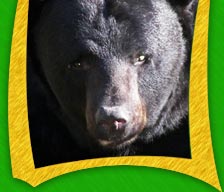|
LOOKIN' GOOD
Florida’s largest native land
mammal is one of three distinct subspecies of the American black
bear recognized in the southeastern United States. It can be distinguished
from other subspecies by the length and shape of its skull. Like
many bears, Florida black bears are powerful, 200 to 350 pound animals
with rounded ears, short tails, 5-toed feet and large canine teeth.
These bears also have thick, curved claws that enable them to climb
tress very well. The Florida bears are black with a tan muzzle and
may have a white chest marking called a blaze.
MMMM ... HONEY
Contrary to what Winnie the Pooh
eats, Florida black bears have a much more diversified diet. They
are omnivorous, which means they eat both plant and animal matter.
A majority of their diet consists of acorns, nuts, berries and
other vegetation as well as insects. A small percentage of their
diet is meat which can consist of raccoons, white-tailed deer and
birds. Bears use a type of feeding behavior called foraging. Foraging
means the animal meanders through an area feeding on appropriate
foods it comes across.
WHERE ARE THEY NOW?
Prior to the late 1800s an
estimated 12,000 black bears roamed throughout Florida from the
Panhandle to the Keys. Since then habitat loss, habitat fragmentation
and unregulated hunting have decreased the number to less than 2,000.
Today the bear population is isolated and scattered throughout the
state mostly within preserved areas such as Big Cypress National
Preserve and Ocala National Forest.
Resources for this article
have been provided by Wikipedia and
the
Florida Fish & Wildlife
Conservation Commission.
|











